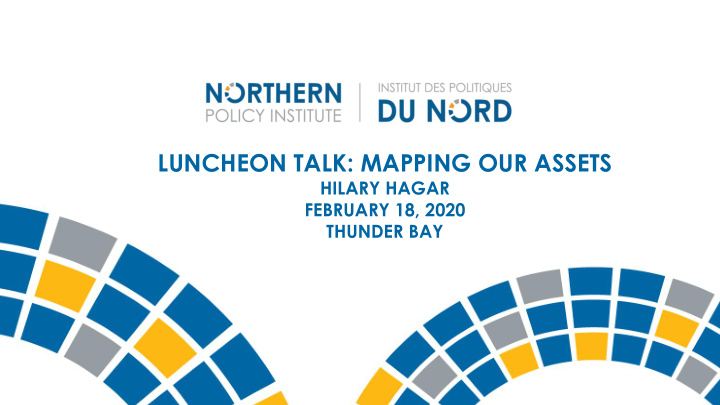



LUNCHEON TALK: MAPPING OUR ASSETS HILARY HAGAR FEBRUARY 18, 2020 THUNDER BAY
Agenda ▪ Introduction ▪ Project purpose ▪ Defining Asset Mapping ▪ Examples and Exercise
Introduction
What is Northern Policy Institute? Northern Policy Institute is a think tank that conducts independent policy work, to provide evidence-based solutions to sustain and grow Northern Ontario. • Independent – authors are free from interference from everyone, including us • Non-partisan – we do not take “sides” • Evidence based – we collect, measure and interpret data • IN the North – we deal with local, regional, provincial, national and international issues from a northern perspective
Project Purpose
Project Purpose Raise your hand if… 1. You know most or all people in this room and what organization they represent 2. You are confident you know every service/resource available to people looking for help connecting to your community 3. You are confident that people (new arrivals and current residents alike) know how to effectively access and locate those services
Project Purpose Raise your hand if… 1. You know organizations similar to yours in your community 2. You know organizations similar to yours outside your community across Northern Ontario 3. You know what gaps exist for people looking for help in your community
Guidance and advice is a necessity… “ Non-refugee respondents indicated they need more info on employment-related information, information in daily life in Canada, and information about regional and local specificities” (IRCC 2018, 33). “50 percent of respondents were unable to find a place of their own and remained in temporary accommodation during the duration of the study” (Distasio, Sylvestre, and Wall-Wieler 2013, 50) “Community belonging and the idea of inclusion and exclusion are closely linked to youth outmigration. Research has also shown that youth must feel accepted by their community in order for them to live in it. A youth that feels like a local has a higher probability of continuing to reside in his community in comparison to one that feels excluded .” (Robichaud 2013, 77)
Defining Asset Mapping
Focuses on community capacity… The process “concentrates first of all upon the agenda building and problem-solving capacities of local residents, local associations and local institutions…” “… not with what is absent, or with what is problematic, or with what the community needs..” (McKnight and Kretzmann 1993, 8)
Current Assets Not what you could do, should do, or hope to do… But what you ARE doing…
A whole assets approach… Our aim is to take into account “all the aspects that are part of people’s view of their immediate community as well as the surrounding rural world ...” “Because communities are not islands unto themselves , it means going outside the community to see what is important about the surrounding and interconnected areas .” (Fuller et al. 2002, 9)
A living process… Once preliminary assets are identified, the result is a “ living document of the community ” that describes the “breadth and diversity” of communities (McKnight and Kretzmann 1993, 10).
Objectives 1. Analysis of strengths and gaps at community and regional – levels 2. Work with partners to promote current assets. Who might use the asset map information? ▪ Current residents ▪ New arrivals ▪ Service Providers ▪ Funders
Where will asset information be made public? ▪ We have approached: ▪ www.211Ontario.ca ▪ www.neoimmigration.ca ▪ www.movetonwontario.ca • Also will be available on: • www.comenorth.ca • www.northernpolicy.ca • Calendar dates will be added to, and updated on: • www.northernpolicy.ca/calendar
Examples and Exercise
Who should complete an Asset map Questionnaire? Everyone: ▪ Thunder Bay Indian Friendship Centre ▪ Nokiiwin Tribal Council ▪ Centre de Francophone ▪ Lakehead University ▪ YES Employment ▪ Thunder Bay Chamber of Commerce ▪ Thunder Bay Ventures ▪ Port Arthur Rotary Club ▪ Fort William Curling Club ▪ 55 Plus Centre ▪ Thunder Bay Public Library
Asset Categories ▪ Marketing and attraction ▪ Language training and translation services ▪ Job matching ▪ Community orientation ▪ Education and training ▪ Housing ▪ Legal services ▪ Healthcare ▪ Entrepreneurial and Financial services ▪ Community connections ▪ Childcare and family services ▪ Cultural awareness training and action against discrimination ▪ Data collection and analysis ▪ Online resources ▪ Other
Asset Map Exercise Throughout the conference, please complete the following exercise 1. Find the sticky notes in front of the asset categories that correspond to your provincial district: Orange & Yellow = Thunder Bay Blue = Rainy River Purple = Kenora Green = Other (please specify) 2. The boards around the room are for each category of service. Write down services in your community that fall into each category. Please keep in mind the criteria discussed earlier. 3. Complete Northern Policy Institute’s Asset Mapping Survey. Check your email for an invitation to complete the survey!
Calendar Exercise Throughout the conference, please complete the following exercise 1. Find the sticky notes in front of the calendars that correspond to your provincial district: Orange & Yellow = Thunder Bay Blue = Rainy River Purple= Kenora Green = Other (please specify) 2. The 6 calendars around the room correspond to the upcoming months from March 2020- August 2020. Write down any events, campaigns, happenings, etc. you have planned for the next 6 months. Place sticky notes in the corresponding month and day. 3. Stay tuned for more information on how to access these welcoming community calendars online.
assetmap@northernpolicy.ca
Thank you. Marsee. ᑭᓇᓈᐢᑯᒥᑎᐣ Merci. Miigwech. 1 (807) 343-8956 | info@northernpolicy.ca www.northernpolicy.ca /NorthernPolicy
Recommend
More recommend